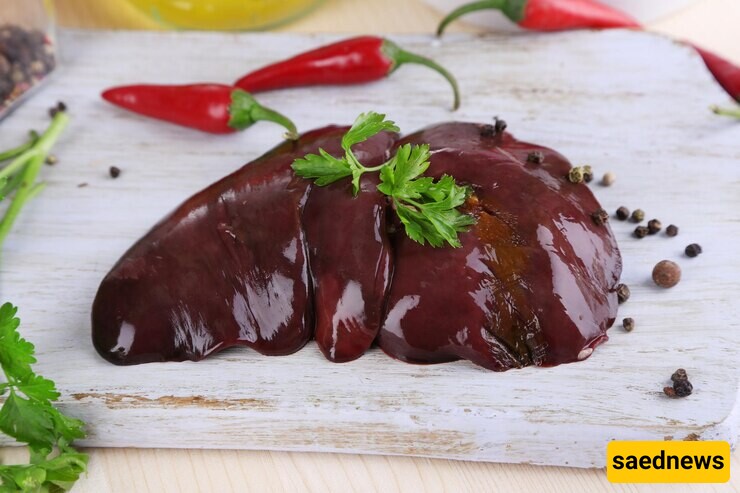SAEDNEWS: White liver is rich in protein, vitamins, nutrients, and minerals. Despite its health benefits, it isn't widely popular. This affordable and nutritious meat can be a healthy choice, but should be consumed in moderation due to potential health risks.


Many people find it hard to resist the aroma of grilled white or black liver skewers from a street vendor—a flavorful and highly nutritious dish. Liver from cows, calves, sheep, and goats is a popular food worldwide, commonly sold in markets and butcher shops.
In Iranian cuisine, dishes made from liver and heart are especially beloved, offering a rich and flavorful experience. Although cooking methods vary from city to city, these dishes are always colorful, tasty, and highly sought after.
White liver, also known as the lungs of livestock, is a nutritious ingredient that can be used to prepare healthy meals. It’s worth noting that black liver refers to the liver organ itself, which is rich in vitamins B, iron, zinc, and vitamin A. According to traditional beliefs, white liver has a warm and moist temperament.
White liver (lungs) offers limited nutritional value compared to black liver but still serves as a source of protein for muscle and body growth. Black liver, however, is far richer in essential nutrients, especially vitamin A.
Black Liver: A protein content comparable to meat but with higher fat levels. It is packed with iron, making it an excellent choice for those with anemia, and contains significant amounts of zinc. Black liver is beneficial for growing children and adults alike. Its high vitamin A content supports healthy skin, prevents dry eyes, and reduces the risk of night blindness.
White Liver: Rich in vitamins D and E, which promote bone growth and combat osteoporosis. It is also a great source of vitamin B12, which helps fight anemia.
Black Liver: 220 calories, 2.5g carbohydrates, 30.5g protein, 8.8g fat.
White Liver: 113 calories, 19.8g protein, 3g fat, and no carbohydrates.
While black liver has greater nutritional value, its higher fat content means it should be consumed in moderation.
Fat Content: White liver has less fat than black liver or red meat.
Protein and Fat Levels: White liver has lower protein and fat content compared to black liver or red meat.
Cholesterol: White liver contains higher cholesterol than black liver or red meat.
Iron: Black liver contains two to three times more iron than beef, while white liver has significantly less iron.
White liver (lungs) is packed with essential vitamins, iron, and zinc, making it a highly nutritious food. It is often regarded as a blood-boosting ingredient due to its high iron content.
Improves Memory and Brain Function:
Rich in vitamin B, white liver supports memory, brain health, and the nervous system. A deficiency in vitamin B1 can lead to fatigue, poor appetite, digestive issues, headaches, dizziness, weight loss, and irritability.
Treats Anemia:
White liver is a good source of B12, which is essential for preventing anemia, nerve damage, and memory loss. Foods such as veal liver, salmon, beef fillets, eggs, and soy milk are also excellent sources of B12.
Boosts Immunity and Skin Health:
Packed with vitamin A (retinol), white liver strengthens the immune system, enhances vision, and promotes healthy skin. Vitamin A can also be found in foods such as calf liver, chicken liver, cheese, egg yolks, butter, spinach, and carrots.
Overconsumption of white or black liver can lead to vitamin A toxicity (hypervitaminosis A) and copper poisoning.
Pregnancy Caution: Due to its high vitamin A content, excessive intake during pregnancy may cause birth defects.
Heart Disease Risk: The high cholesterol in white liver makes it unsuitable for individuals with heart conditions, as it may increase the risk of heart attacks.
To make the most of white liver’s benefits, it can be prepared in several ways:
Grilling: Simply grill the liver pieces for a quick and flavorful meal.
Stewing:
Cut the liver into small pieces, removing any excess tissues.
Rinse the pieces thoroughly and boil them in water until any foam forms. Discard the foam and rinse the pieces again.
Place the liver pieces in a pot with water and a chopped onion. Simmer on low heat for about 1.5 hours.
Separately, sauté sliced onions, bell peppers, hot peppers, and minced garlic in oil. Add the cooked liver and stir-fry until well combined.

